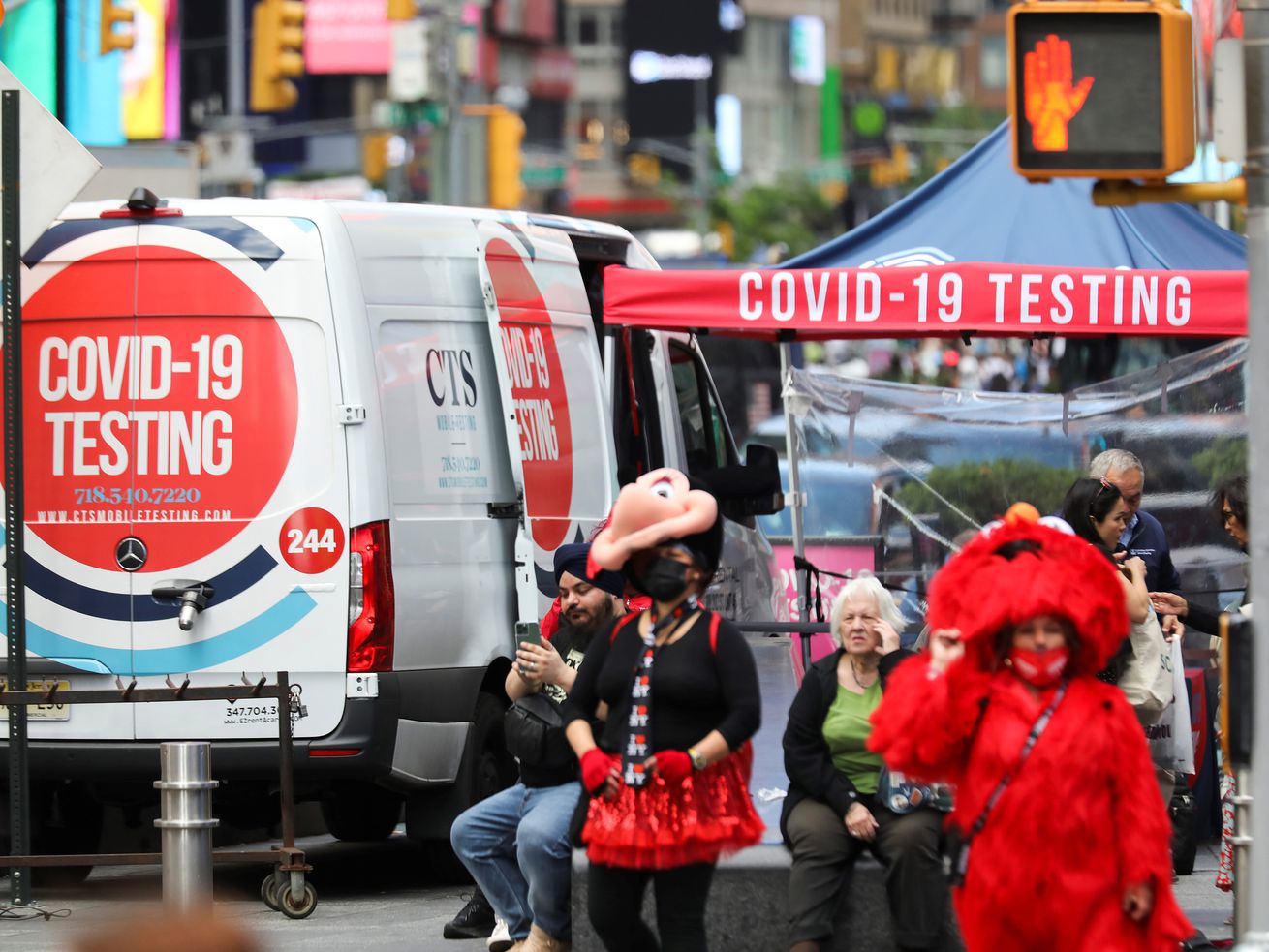The omicron variant of Covid-19 has branched out into more transmissible and evasive versions.
After the month of May saw the United States cross the line of more than 1 million reported deaths from Covid-19, the SARS-CoV-2 virus that causes the disease is continuing to mutate. That means a growing number of new omicron subvariants are now fueling another rise in infections. The formula for containing the worst effects of the pandemic — namely vaccinations and treatments — still holds up. But progress has been slow, leaving the world vulnerable to more troubling changes to the virus.
The US is inching closer to authorizing Covid-19 vaccines for one of the last unprotected age groups, children under 5 years old. Pfizer and BioNTech reported preliminary data this week that a three-dose sequence of its Covid-19 vaccine yielded 80 percent efficacy in preventing disease in kids between six months and 5 years old. But the Food and Drug Administration will not meet until next month to consider granting emergency approval for these shots.
Treatments have also hit some snags. The mutations in omicron have rendered several monoclonal antibody treatments ineffective. Some doctors have also reported that Covid-19 symptoms in patients rebounded after completing a course of the antiviral drug Paxlovid.
All the while, another wave of Covid-19 cases is poised to wash over the US as summer heat forces people back indoors, creating more opportunities to spread the virus. Many parts of the country have also lifted face mask requirements and social distancing rules. Covid-19 cases number around 100,000 per day, but the rise of at-home testing means the official tallies are likely an underestimate, if people bother to get tested at all.
“We know that the number of infections is actually substantially higher than that,” said Dr. Ashish Jha, White House Covid-19 response coordinator, during a press conference last week. “[It’s] hard to know exactly how many, but we know that a lot of people are getting diagnosed using home tests.”
Covid-19 hospitalizations are now rising across the country as well, which means deaths may soon follow. For much of the country, Covid-19 will get worse before it gets better, though likely not anywhere near as bad as it was in January.
/cdn.vox-cdn.com/uploads/chorus_asset/file/23585415/us_state_trends.png)
Centers for Disease Control and Prevention
The good news is that the number of deaths and severe illnesses does appear to be separating from the number of cases from omicron. That’s due in part to effective Covid-19 treatments being more available for those who fall ill.
It’s also a consequence of the current stage of the pandemic. Between Covid-19 vaccines and infections from the virus, there are few people left who have had no exposure at all to SARS-CoV-2. Most have some degree of protection against the virus. Covid-19 vaccines, in particular, still prevent severe illness from new variants.
But the level of protection isn’t the same across the board. Resistance to infection fades with time, so booster doses of vaccines are critical to shoring up immune defenses ahead of new waves. Yet despite expanded eligibility, less than half of people in the US who have received a Covid-19 vaccine have had a booster shot. More than 20 percent of US residents have not received any Covid-19 vaccine doses. Meanwhile, about two-thirds of people across the world have had at least one dose of a Covid-19 vaccine.
Such widespread variation in immunity means the SAR-CoV-2 virus can continue to spread and mutate. But scientists have long warned that it also creates selection pressure to favor versions of the virus that can evade immunity and spread more readily. Recent research shows that prior infections are not enough on their own to prevent reinfections, even from similar versions of the virus.
That’s playing out now with the rise of the BA.2.12.1, BA.4, and BA.5 subvariants of omicron, which itself was a more transmissible version of the original SARS-CoV-2 virus. “They are more contagious with more immune escape, and they are driving a lot of the increases in infection that we’re seeing across the nation right now,” Jha said.
As the Covid-19 pandemic stretches into its exhausting third year, the virus is killing fewer people but still taking a huge toll on health and the economy. Drawing this down further demands a more concerted effort to close gaps in vaccination, make treatments more accessible, and detect mutations in the virus before they spread widely. Otherwise, the cycle of new variants causing more infection waves will continue.
The new omicron subvariants appear more likely to cause reinfections
Viruses exist to make copies of themselves, but they’re pretty clumsy at it. The more a virus spreads, the more it mutates. Most of these changes are harmful to the virus or have no effect, but occasionally a mutation crops up that gives the virus an advantage, like making it easier to catch or harder to detect.
The World Health Organization decided that when a version of SARS-CoV-2 acquired a distinct grouping of mutations, it would become a named variant and get a shorthand classification with a Greek letter — alpha, beta, gamma, and so on.
There is actually a range of changes within every variant, but after the omicron variant erupted in late 2021, a specific subvariant called BA.2 began to dominate new infections. It’s not genetically distinct enough to get its own Greek letter, but BA.2 had such a commanding advantage that researchers and health officials focused on it.
Since then, BA.2 has continued mutating and optimizing itself. Its latest form is BA.2.12.1, which is now beginning to make up a larger share of new cases in the US.
/cdn.vox-cdn.com/uploads/chorus_asset/file/23583411/Screen_Shot_2022_05_23_at_3.02.48_PM.png)
Centers for Disease Control and Prevention
Other parts of the world are seeing different subvariants. South Africa, which has generally been ahead of the US in terms of emerging versions of SARS-CoV-2, is now reporting the rise of BA.4 and BA.5 subvariants, which they detected in January and February, respectively. They don’t appear to cause any different symptoms, but together they account for about half of new infections in South Africa. These subvariants have also been detected in wastewater in the US, but still remain a minority of cases.
In general, the subvariants gain ground because they spread more easily between people and are harder for the immune system to target. That means they are more likely to cause breakthrough infections in vaccinated people and reinfections in those previously infected.
“The thing with omicron, though, and all the [subvariants] therein, is now a lot of the growth advantage is driven by reinfections,” said Dr. Aaron Richterman, an infectious disease fellow at the University of Pennsylvania.
Vaccines and infections coach the immune system to make antibodies, proteins that can inhibit a virus from causing an infection. Antibody levels naturally wane over the course of several months, but the immune system still has memory cells that can mount defenses if the virus comes back. The trouble is, these memory cells can take several days to spool up, during which time, a fast-incubating virus like SARS-CoV-2 can take root and spread to others, especially if it’s mutated. That’s why people who received their shots can still get infected and transmit the virus, though the vast majority of them will not become severely ill.
Boosters do shore up antibody levels to prevent infections in the first place, but these effects also fade with time. The Centers for Disease Control and Prevention now recommend a fourth vaccine dose for mRNA vaccines given to people who are immunocompromised.
The winter omicron wave hints at what the new subvariants might do
The parent of these subvariants, omicron, provides some important lessons about what to expect with BA.2.12.1, BA.4, and BA.5. Omicron stands out from past Covid-19 variants because it has so many changes, close to 50 mutations compared to the original SARS-CoV-2 virus. Many are in the virus’s spike protein, enhancing how it breaks into human cells and making it harder for the immune system to target.
So protection conferred by the previous versions of SARS-CoV-2 doesn’t translate as well to omicron and its subvariants.
Omicron also appears to replicate much faster in the upper airways, making it easier to breathe out virus particles and spread them to others. Health officials warned in January that omicron would “find just about everybody.”
The result was that this past winter, omicron triggered a massive spike in Covid-19 cases in the US followed by an equally sharp decline. Some researchers theorized that omicron’s long reach would infect so many people across the population that it would effectively act as a vaccine, albeit one that came at an immense cost in human lives. In states like Massachusetts, the omicron wave was deadlier than the delta wave.
But new research shows that an omicron infection is a poor substitute for a vaccine. In a study published last week in the journal Nature, researchers looked at immune responses in mice and humans after infection with different variants. They found that an omicron infection provided little shielding against other versions of the virus.
“Omicron by itself sweeping through the world is not going to induce a very robust immune status protective against other variants in the future if you are not vaccinated,” said Dr. Melanie Ott, an author and a senior investigator at the Gladstone Institute of Virology and Immunology at the University of California San Francisco.
On the other hand, an omicron infection after vaccination yielded a broader spectrum of protection against other variants. “The message is really get vaccinated even if you have been infected,” Ott said.
As for BA.2.12.1, BA.4, and BA.5, these new subvariants appear to dodge some of the immunity generated by BA.1 and BA.2. So people infected with earlier versions of omicron could still contract the more recent subvariants. That will likely fuel more Covid-19 cases throughout the summer.
“Even slight changes to omicron in these new variants seem to be sufficient to actually circumvent this neutralizing activity,” Ott said.
It’s also likely that these reinfections will be annoyances rather than debilitating diseases in most people. But there are still people with serious risk of dangerous illness, like those who are immunocompromised and older adults. And even mild infections can have lasting consequences like long Covid, so it behooves everyone to take steps to avoid getting infected in the first place.
Covid-19 may surge, but there are ways to stay ahead
The ongoing spikes and drops in Covid-19 cases mean it hasn’t yet settled into the regular pattern of an endemic disease, but it’s getting closer, and the gap between infections and severe disease appears to be widening.
“Until we get to that steady state, we should expect that every subsequent wave is less severe than the one before it,” Richterman said. “In general, we can expect that, over time, the overall burden of severe disease is going to go down.”
At the same time, immune protection varies drastically in the US and around the world. There are people who have received four doses of a vaccine and have been infected, while there are others who still have not encountered the virus. That has created the ideal training ground for new variants. Closing off these routes for new variants will require administering vaccines around the world, as well as ensuring everyone who is eligible for a booster gets one.
Staying ahead of variants and subvariants also demands vigilance, from looking at wastewater to predict looming infection spikes to sequencing genomes of the virus to identify new mutations. And if a new variant arises that does lead to a large increase in severe illness in vaccinated people, then the vaccines themselves might need to be updated to target the more recent versions of the virus.
Progress against Covid-19 is fragile, and with more than 6 million dead around the world, it’s proven costly. But as tired as everyone is from dealing with the pandemic, the virus doesn’t care, and we cannot take the disease for granted.
Author: Umair Irfan
Read More



